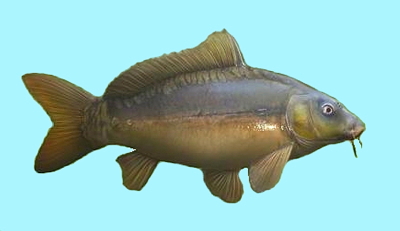|
|
Leather Carp, its habitats, characteristics, fishing methods and techniques.
Carp are generally considered a nuisance by North American anglers, they are highly prized as sportfish in Europe, as they are often excellent fighters. A growing number of anglers in the US are becoming interested in carp as a sportfish. Although flavor varies with the quality of the water from which fish were captured, their sheer abundance has made them an important food fish in some areas. Carp are presence in nearly all of our rivers, streams, and reservoirs. They are omnivorous (eating both plants and animals), their bottom feeding habits causing great destruction of aquatic resources.
A combination of understanding the fish and the techniques used to catch them will help you to hook more fish to the end of your line. Better knowing and understanding of the fish that you are trying to catch will make you a more successful angler, whether you are fishing for trout on a river or surfing on the beach or trolling on the open water.

|
Leather Carp - scaleless domestic carp, large Old World freshwater bottom-feeding fish introduced into Europe from Asia; inhabits ponds and sluggish streams and often raised for food; introduced into United States where it has become a pest.
|
Description
A heavy-bodied, laterally compressed fish with a long dorsal fin and arched back. The first ray of the dorsal and anal fins is a stout, serrated spine. The small triangular head tapers to a blunt snout. The small, protrusive mouth contains no teeth and is located below the snout. There are two pair of barbels on the upper jaw. Body color is brassy green on top grading to bronze or gold on sides. The belly is yellowish white. Fins typically are yellow, orange, golden, or light olive in color. This fish typically gets its name from the distinct lack of scales therefore its skin resembles pure leather hence the name Leather Carp.
A perfect Leather Carp is completely devoid of any scales. However, they are allowed to have scales along the dorsal line and at the wrist of the tail. The anal fin often has fewer rays than commons and mirrors and the dorsal fin is often imperfect. Leather carp (and Linear carp) both carry a potentially lethal gene, making them less hardy than other species of King Carp. Leathers have less blood pigment than other carp, giving them their unique appearance. They have a reduced immune system response and are more vulnerable to viruses and are more likely to survive in oxygen depleted waters. A perfect Linear carp has a complete straight line of single scales running along the lateral line from the head to the tail.
In captivity carp have lived as long as 47 years, but in the natural wild environment the true age is still unknown. Carp generally grow rapidly for the first few years until they reach sexual maturity and then slows as energy is diverted into reproduction.
Habitat and Habits
Leather carp are extremely adaptable fish. They can tolerate a wide range of temperatures (up to 96-degrees). This adaptability allows them to dominate many bodies of water that they inhabit, that range from large flowing rivers, cannel's, natural and manmade lakes. Leather carp will prefer soft bottom areas such as muddy grasses or sand. Although they will congregate near deep-water drop-offs, they prefer to inhabit shallow waters and many a time you will hear them sucking at the backside Vegetation.
Carp are omnivorous feeders, taking both vegetable and animal matter in their diet. Aquatic insects, crustaceans, and small mollusks make up the bulk of their forage. They are particularly fond of tender roots and shoots of young aquatic plants and often "root-up" large quantities of vegetation and silt in their search for food. In commercial waters carp have become reliant on anglers bait who can introduce large quintiles of particles or high protein boilies. Carp feed both during the day and night, however on pressured waters carp naturally feed during the quietest times normally at night.
Fishing Methods.
In Europe, carp rank third among sport fishes behind
Atlantic Salmon and
Rainbow Trout. Carp are powerful and can grow quite large so appropriate tackle is required. Pound for pound, carp will put up a fight equal to most sport fish. Carp can be caught on a wide range of tackle which really depends on the situation. As in blue water game fishing there is an increasing trend to fish with lighter sporting tackle. On each Angling Direct Holidays tour page is detailed what tackle is recommended for these locations. Methods also vary from match anglers pole fishing, specialist anglers using baits on the surface (Floater fishing) to the most sophisticated bottom rigs including variations of the famous bolt and hair rigs. The choice basically is endless.
|
|
|

